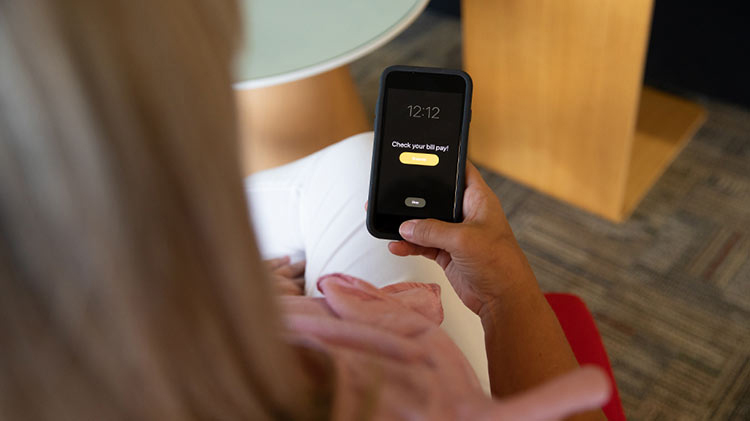Prevent identity theft with these simple tips
Help prevent identity theft by following cyber security best practices. If you are a victim, discover how to start restoring your identity today.
The Federal Trade Commission (FTC) receives millions of consumer reports about identify theft, fraud and other consumer protection issues a year. In 2023, they received 2.6 million fraud reports. The number of identity theft and exposed consumer records containing personally identifiable information (PII) has been increasing. The good news is you can take some measures to help protect your digital devices and your personal information and help lower your risk of exposure to this crime.
How to protect yourself from identity theft
Here are some simple steps to help protect your identity:
- Keep software up to date. Technology companies are regularly monitoring their software for weak spots or security breaches and often release updates to help fix those issues. Set up your devices to receive automatic updates.
- Install antivirus software and a firewall. Both are a great baseline in the battle against cybercrime; antivirus software detects malicious infections, while a firewall fends off outside access. Although a variety of free options exist, you may want to invest in a paid version that offers more updates.
- Check web addresses. Anytime you're providing financial information, such as credit card numbers, double-check the web address: It should begin with "https" and display a padlock sign, meaning you are securely transmitting information. And remember, if you're using a public network, your information can be more vulnerable.
- Never click on suspicious links. Cyber thieves are masters at creating emails that imitate trusted vendors and sites. If an email is asking to verify personal information, demanding money or promising a refund, visit the website directly or call its customer service line to check its legitimacy. If you hover over a hyperlink in an email, a phishing scam will often reveal an unusual URL or one with a slight misspelling.
- Rely on two-factor authentication (2FA). Another powerful tool that adds an extra layer of security to logins and helps discourage cybercrime is two-factor authentication. It requires a username and password for the first factor and another piece of personal information, such as a security question or a one-time code sent to your phone, as the second factor.
- Don't send personally identifying information via email. Never email your credit card information, Social Security number, driver's license number or other financial or identifying information — especially if your email is unencrypted. Email is an easy way for hackers to snatch sensitive information.
- Review your bills and credit card statements. This will help identify any potential misuse of your identity in the month it happens so you can take immediate steps. Also, take advantage of the free credit report you are allowed each year. Afterwards, remember to save any documents you wish to keep in a secure location or shred them.
- Keep your social security card safe and get your mail. Place your Social Security card and other valuable documents like birth certificates in a fireproof safe or other secure place in your home. Retrieve and secure your mail every day so that you can review documents such as credit card offers, statements or other forms with identifying information. Shred these documents when you no longer need them. Remember to either have a trusted friend or neighbor collect your mail and put your mail on hold if away on a business trip or a longer vacation.
- Beware of shoulder surfing. This technique happens when someone grabs valuable information by watching over your shoulder and includes things such as ATM PIN numbers, credit card numbers and passwords.
- Protect your devices. Set up lock screens for all of your devices, including cell phone, tablets and laptops. Also avoid leaving them unattended in public places, and take precautions when using public Wi-Fi. If you are using your laptop in a public place, consider using a privacy screen to reduce the possibility of other people looking at your files or documents. These screens are also available for cell phones.
- Protect your credit card. Do not leave your credit card out where others can see it and be on the lookout for credit card skimmers.
- Be smart about social media. Many apps on social media have fun surveys, games and quizzes with questions about favorite food, school, age or other personal details, to name a few examples. These are sometimes engineered to gather personal information about you, so be aware.
- Clean up your digital devices. If you are selling, donating or disposing of your laptop, tablet, cell phone or computer, delete all your personal information and files before you give them away. The FTC has a step-by-step guide you might consider to assist you in this process.
- Beware of spoofing and phishing calls. Scammers will pretend to be someone they are not and attempt to get your personal information. Don’t give any personal or financial information over the phone, even if the caller identifies themselves as your banking institution, a government agency or family friend. In some cases, the caller will use the excuse of an urgent request or that something bad may happen if you don’t release the information to them right away. Instead, call the institution, friend or government site and verify if they are trying to contact you.
- Set up financial alerts. Many banks and credit card companies offer alerts to your phone or email any time unauthorized purchases or transactions are made on your accounts. As a result, you can contact your institution immediately to address any possible issues.
How to prevent identity theft after losing your wallet
If you find yourself in this situation, here are some steps to help minimize your identity theft and fraud risk:
- Lock your card or contact your bank or credit card company. Call your bank and credit card companies to stop any future transactions and order new cards with new account numbers. As an alternative, many credit card providers will allow you to lock your credit card prior to fully canceling. Doing so immediately can give you time to search for your wallet while knowing fraudulent charges can’t be made.
- Verify account statements. Once you’ve determined the card is missing or stolen and it’s been reported, validate all the transactions on your statements and notify the financial institution of any irregularities. And remember to address any automatic payments coming out of an account you cancel.
- Report your lost wallet. Filing a police report offers a chance to recover your wallet and provides some protection against identity theft. Request a copy of the report for your records.
- Replace your lost driver’s license. Contact your local Department of Motor Vehicles to learn how to replace your lost ID. Some offices offer online replacement services, while others require you to appear in person.
- Change your passwords. If your wallet was stolen, it’s possible the person responsible has gained access to some of your accounts and passwords using your personal information. Consider creating new passwords for your accounts to help deter further harm.
- Order a credit report. A person in possession of your identity may use it to apply for loans or open new accounts in your name. You can request a free credit report that can help identify any unauthorized accounts or activity. If unfamiliar activity is detected, notify Equifax, Experian and TransUnion.
- Report the loss to your insurance companies. If your medical and auto insurance cards were lost, let your insurance companies know so they can issue a new card and watch for fraudulent behavior on your account.
- Contact the Social Security Administration (SSA). While it’s recommended to not carry a social security card on your person, if there was anything in your wallet that shows your number, contact the SSA immediately to let them know of the theft and, if needed, request a replacement card.
How to report identity theft
According to the Federal Trade Commission (FTC) site, below are some possible steps to help if you are a victim of identity theft.
- Contact the company where you think your identity fraud happened. Explain your concerns and ask that they close or freeze your accounts. You should then change all logins, passwords and PINs on your accounts.
- Contact the credit bureaus and place a fraud alert. These alerts can be placed by any of the three credit bureaus and will remain in place for one year. When you place an alert with one of the bureaus, they will send requests to the other bureaus to do the same. The fraud alerts will make it difficult for anyone to open new accounts in your name.
- Report the identity theft or fraud to the FTC. Using an online form, you can report identity theft or fraud with the FTC. Based on the information you enter, they will create an Identity Theft Report and recovery plan.
- File a report with your local police department. You might need the FTC identity theft report, your ID, proof of address and any notices related to the theft in order to file it. The police report may be needed as you work to recover your identity.
- Start repairing the damage. With your FTC Identity Theft Report, contact each of the businesses where someone opened an account in your name and request it be closed. Plus, request they:
- Remove bogus charges from your account
- Remove all accounts from your credit report
- Consider adding an extended fraud alert or credit freeze. This can help prevent further use of your stolen information.
Consider ID restoration insurance
Prevention is the key to protecting your identity from being stolen and used by criminals. For added protection, insurance companies are now offering insurance to assist with identity restoration. State Farm® offers Identity Restoration Insurance to help make the recovery process easier, faster and less expensive. Contact a State Farm agent today to learn more.




